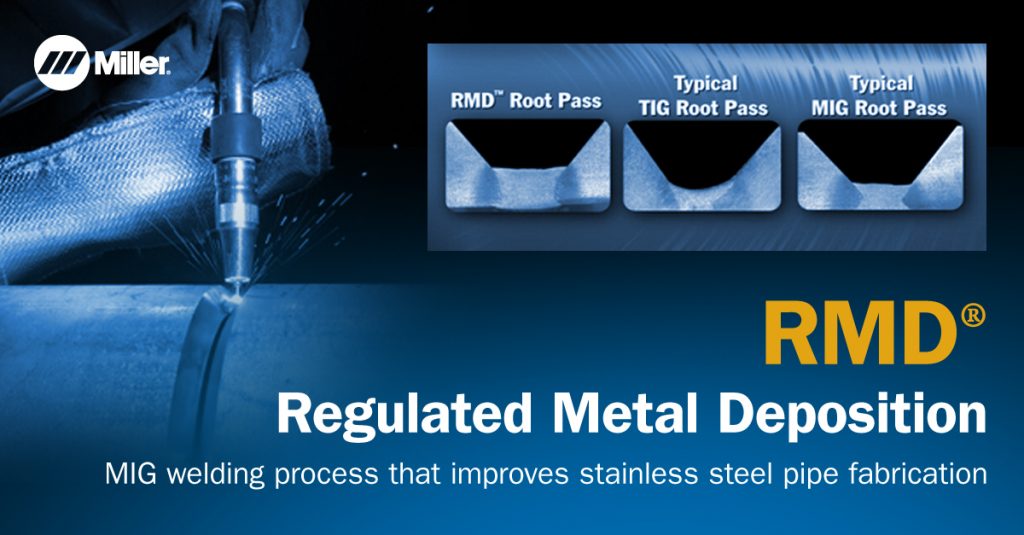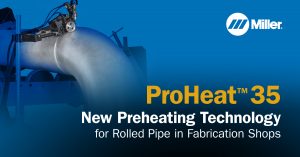Miller’s Regulated Metal Deposition (RMD®) MIG welding process (modified short-circuit MIG) improves welding quality and productivity on stainless steel pipe. The RMD process is easy to learn and addresses the welder shortage by providing an easier process that gets more work done faster and at a higher quality.
Executive Summary
- Precisely-controlled metal transfer provides uniform droplet deposition, making it easier for the welder to control the puddle.
- Easily bridges gaps up to 5 mm (3/16-in.) and creates more consistent root reinforcement on the inside of the pipe.
- Shielding gas comes out of the gun relatively undisturbed, pushing through the root opening and preventing sugaring on the back side of the weld. This allows certain 300 series stainless steels to be welded without a backing gas, which can improve productivity by as much as 400 percent.
- RMD maintains a consistent arc length regardless of stick-out.
- The amount of the root pass metal deposited will be sufficient to supply the heat input requirements of the first Pulsed MIG or flux-cored fill pass, possible eliminating the need for a TIG hot pass.
- Same wire and shielding gas can be used for the fill and cap passes using a next generation Pulsed MIG process called Pro-Pulse™, which improves travel speeds and deposition rates while lowering heat input.
Finding qualified welders is already difficult, and it’s only getting worse. To meet demand, stainless pipe fabrication shops already work hard. Now they have an opportunity to work smarter by substituting a modified short circuit GMAW processes, called Regulated Metal Deposition (RMD®), for the traditional GMAW and GTAW processes for the root pass.
Changing the Game
Pipe fabricators are particularly skeptical about short circuit GMAW, and with good reason. With traditional GMAW, the short circuits occur at erratic intervals and with varying intensity. As a result, the weld puddle experiences a great deal of agitation. To prevent cold lap, or lack of fusion, the operator must work to control and manipulate the weld puddle. High-speed video demonstrates how the short circuit “explosion” causes the weld puddle to splash up and freeze on the sidewall of the pipe, which is how cold lap occurs. It also leads to spatter and extensive clean-up time.
Because it takes a great deal of skill to produce code-quality root welds with traditional short circuit GMAW, many fabricators shun the process, and many end users do not include it in their list of approved procedures. Fortunately, technology advances are changing the game.
With RMD™ technology, the welding system anticipates and controls the short circuit, then reduces available welding current to create a consistent metal transfer. Precisely controlled metal transfer provides uniform droplet deposition, making it easier for the welder to control the puddle. High-speed video proves that stable short circuits create only small ripples in the weld puddle, which in turn allow consistent tie-in to the sidewall. With a stable and more controllable weld puddle, apprentice operators can quickly and easily learn to create uniform, high-quality welds.
The RMD process also provides several other benefits. First, the smooth metal transfer compensates for a high-low misalignment between pipe sections. It easily bridges gaps of up to 5 mm (3/16 in.). Second, smooth metal transfer creates more consistent root reinforcement on the inside of the pipe.
Third, the shielding gas coming out of the gun remains relatively undisturbed by the controlled transfer. As a result, enough shielding gas gets pushed through the root opening to prevent sugaring (oxidation) on the backside of the weld. Some fabricators have qualified procedures to weld some of the 300 series stainless steels without a backing gas, improving productivity by up to 400 percent (large diameter pipes take a long time to purge, and the gas is costly).
Fourth, the RMD process maintains a consistent arc length regardless of electrode stick-out. It compensates for operators that have problems holding a constant stick-out, and it enables a better view of the weld puddle.
Note that as apprentice operators weld from the 4- to 6-o’clock position, they tend to increase their wire stick-out. With older technology, a long stick-out skews welding parameters and often leads to quality issues.
Fifth, RMD creates a root pass weld with a 3.2 – 6.3 mm (1/8- to 1/4-in.) throat. In many instances, the amount of root pass metal deposited will be sufficient to support the heat input requirements of the first pulsed GMAW or FCAW fill pass. Fabricators can eliminate the GTAW hot pass., saving time and money.
Finally, the same wire and shielding gas can be used for the fill and cap passes using a next-generation pulsed GMAW process called Pro-Pulse™. This process improves performance and operator acceptance compared to traditional pulsed welding, and it improves both travel speeds and deposition rates while lowering overall heat input.
Interested? Learn more about Regulated Metal Deposition: RMD®




